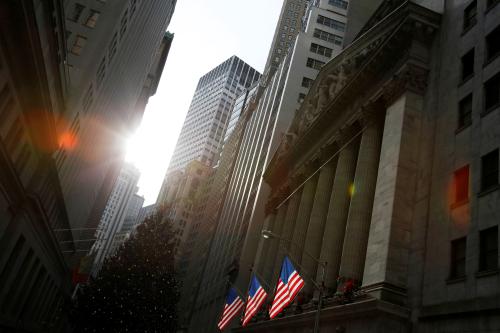In one sense, the Federal Reserve’s confusing announcement of its annual bank stress test results reflects the awkwardness of an agency trying to take account of an unexpected development without departing too much from established procedures. But, coming on the heels of other measures, the episode suggests a more disturbing conclusion: The Fed seems to have forsaken the original purpose of stress testing, namely, to ensure the resiliency of the banking system in the face of uncertain, but potentially severe, risks. The stress testing regime that is emerging appears little more than a compliance exercise.
First, the confusion. The stress test was just underway in March as the dimensions of the COVID crisis became clear. The resulting market turbulence, and staggering declines in employment and GDP, instantly rendered stale the “severely adverse” stress scenario announced only a few weeks before. The prospect, still with us, of a protracted serious drag on the economy because of the medical need to restrict human gatherings injected enormous uncertainty into the economic outlook. It was immediately apparent that the stress scenario announced in February was not nearly as severe as the path the economy was following because of COVID.
Faced with this, the Fed had three options. First, it could shift gears quickly by substituting a COVID-informed stress scenario for the stale one. Second, it could suspend the dated stress test until markets stabilized and then recommence with an updated scenario. Third, it could soldier on with its original test, ignoring the potential impact of COVID on bank earnings and losses.
The Fed essentially chose the third option, but it added a feature that is the source of the confusion. While it continued with the stale stress test, it also undertook a “sensitivity analysis” of bank balance sheets based on three possible scenarios for the COVID-afflicted economy. According to the Fed, the scenarios are less detailed than those used in actual stress tests. Their purpose is “to understand the implications of quite plausible downside scenarios from our current position for bank capital.”[1]
Confusion arises for two reasons. First is the asymmetric transparency of the two exercises. Although the stale stress test results have been released to the public on a bank-by-bank basis as usual, the results of the sensitivity analysis have been released to the public only in the aggregate, with some ranges indicating how many banks may fall into certain categories of projected losses. So we have full information about a largely irrelevant stress test, but limited information about the relevant analysis. The Fed has not stated whether the bank-by-bank results have been made available to the banks themselves.
The Fed might be less certain of these results on a bank-by-bank basis, since they are not the product of the established stress testing regimen. But this gets us to the second cause for confusion. While the Fed has said that the “stress capital buffers” that set the capital requirements for the largest firms will be based on the stale stress test, it has also said that the results of the sensitivity analysis “will help us judge whether banks would have enough capital if economic and financial conditions were to worsen.”[2] But how? That is precisely what the stress test is supposed to do. If the sensitivity analysis isn’t good enough to derive meaningful bank-by-bank results that can be released to the public, how is it good enough to set capital requirements?
There are many unanswered questions. The Fed’s release of the results of the sensitivity analysis indicate that under the two less optimistic scenarios, “a number of firms could experience significant capital depletion and several would approach minimum capital requirements.”[3] Which firms? How close? Given the admitted roughness of the sensitivity analysis, doesn’t this result reinforce the need for a true stress test before capital distributions of any sort are allowed from the firms in question?
In its release on June 25, the Fed announced certain actions based on the sensitivity tests. But there is less to those actions than meets the eye. The Board has required the banks to suspend stock buybacks for the third quarter. The largest banks had voluntarily suspended buybacks in the second quarter. The Board is also capping dividend payments and allowing dividends based on recent income. But that is entirely backward-looking. The Fed is allowing distributions of capital that could be needed to buffer future losses on the ground that the banks were profitable last year.
Finally, the Fed announced that the large banks will be required to resubmit and update their capital plans later this year, one of the actions that should have been taken along with all the emergency measures adopted by the Fed to support markets and financial firms in March and April. But the Fed did not say whether it will actually conduct a real stress test at that time.
From the banks’ perspective, the most important point in the Fed’s announcement is that for now they will be able to proceed with most, if not all, of their anticipated dividends.
The greatest value of a stress test is shortly after a major economic shock that threatens a serious strain on the banking system. A supervisory stress test of major banks will use a scenario that posits a plausibly bad, though not worst, case unfolding from the specifics of the economic shock that has occurred. The results help gauge the resiliency of the banks to the bad scenario. Supervisors can then determine how much, if any, capital each bank can safely distribute, and whether any banks need to raise capital to guard against the adverse outcome before their balance sheets deteriorate amid mounting losses.
This, of course, is what the Fed did in 2009 with its Supervisory Capital Assessment Program (SCAP). The stress test results gave supervisors, markets, and banks themselves much better information on the resiliency of the system. Ten of the 19 participating banks needed to raise capital in the aggregate amount of $75 billion. As a result, even as unemployment continued to rise and even though the recovery was a slow one, the U.S. banking system supported economic recovery. Because of the post-crisis reforms, banks were substantially better capitalized going into this crisis than the last one, so the implications of a COVID-based stress test for bank capital policies could be different. Without the results of an up-to-date stress test, we just don’t know.
Why, then, in the face of an unprecedented economic situation and the powerful precedent of the 2009 SCAP, didn’t the Fed quickly pivot to a meaningful stress scenario, require resubmission of banks’ capital plans, and suspend dividend distributions to preserve capital in the interim until more was known? Why is it waiting at least half a year to require resubmission and allowing dividends to continue? I have a heard a number of possible reasons.
First is the argument that by relaunching the stress test, and suspending all capital distributions until the results were available, the Fed would have sent negative signals to markets about the soundness of the large banks. But in March the Fed’s concern would have arisen not from what it knew, but from what it didn’t know. Precisely because a severely adverse scenario arising from the COVID shock was so different from the 2008-2009 shock, neither the Fed nor the banks had systematically worked through the implications for bank balance sheets. On the other hand, if the Fed were to act later this year on bank capital positions and distributions, after months of supervisory analysis, markets would correctly read this action as a significant signal that banks may already be in trouble.
A second argument is that because the course of COVID and public health policies are so uncertain, there’s no point in doing a stress test. Well, yes, there is considerable uncertainty. And yes, the Fed would need to make a judgment on the severe, but not worst, case outcome. That is the best that can be done under the circumstances. A stress test based on a severely adverse version of this exercise would achieve what stress testing is supposed to achieve—the best available assessment of the losses that banks might sustain. As it is, the Fed is assessing the resiliency of the banks based on the February scenario, which it acknowledges is similar to the most optimistic of the three COVID scenarios in its sensitivity analysis—a V-shaped recovery.[4]
Like some bankers, some Fed officials have suggested that if things do get worse in the future, then provisions for losses might be increased and dividends might be restricted. One can understand the banks taking this position. They want to continue returning capital to their shareholders and do not want to project any weakness to counterparties and markets. But from the Fed’s perspective, with its mandate of protecting the economy, the aim should be to assure resiliency of the banking system early on. Should a stress test reveal the need for bigger capital buffers in a projected bad scenario, it is more effective to restrict dividends or raise capital now than to wait for the bad scenario to become the most likely outcome.
It’s important to emphasize that a stress test determination that banks may need higher capital buffers to absorb losses from an adverse outcome is not an increase in capital requirements. A key premise of the Fed’s new stress capital buffer regulation is that the calculation of stressed losses is a substitute for the fixed capital conservation buffer applicable to all banks. In effect, the ongoing requirement of a capital conservation buffer for systemically important banks is what the stress test determines. The aim, again, is to ensure that these banks can continue to lend to creditworthy customers even if the adverse scenario occurs. Having more capital will not disincentive sound lending, either now or in the future.
A third argument is that the Fed would have undermined its own credibility by suspending capital distributions and shifting to a relevant scenario. The argument here is that the Fed’s stress test last year concluded that banks could sustain a severely adverse scenario, continue to distribute capital, and still remain viable financial intermediaries. So any suggestion that this might not be the case would be an admission that the Fed was wrong last year.
This argument misunderstands the role of stress testing during a period of relative stability. While people sometimes speak as if the results of each year’s stress test guarantee that banks could continue to extend credit under any imaginable stress, this is loose talk. Stress testing can be an excellent supervisory tool. But it is an evolving and necessarily incomplete tool, not a regulatory talisman.
Each year the Fed must choose a stress scenario based on its best judgment of financial system risks. But neither the Fed nor anyone else knows the actual stress scenario banks will one day face. The impact of various possible shocks on bank losses and revenues can vary enormously. If it were logistically possible, the Fed might run dozens of scenarios each year and still not capture the actual crisis. Indeed, who would have included a COVID scenario in pulling together scenarios last year?
A related argument is that it is important for the Fed to stick with the annual stress testing and CCAR processes that it has established: since the annual test was started, it needed to be completed. This is an especially odd argument. While it has been good to regularize the standards and procedures associated with stress testing, the Fed’s own regulation provides that it may require bank holding companies to submit new capital plans because “changes in financial markets or the macro-economic outlook that could have a material impact on a bank holding company‘s risk profile and financial condition require the use of updated scenarios.”[5] Sticking with an obviously stale scenario during an actual economic shock undermines the very purpose of stress testing.
Finally, there is the argument that the Fed just didn’t have the time to change course. Why not? The crisis hit at an early stage of the annual CCAR exercise. And even if a few more weeks would have been necessary, why not adopt an interim emergency change to the Fed’s usual deadlines? After all, since the onset of the crisis, the Fed has adopted numerous interim emergency measures relaxing bank regulatory and reporting requirements.
In recent years, the annual stress test had already shown signs of ossification, as the Fed increasingly accommodated the banks’ preference for more predictability. Though it has not released the actual code of the supervisory model, the Fed has published enough relevant information that the banks probably have a working approximation of the model itself. The severely adverse scenario adopted by the Fed each year has changed somewhat, but not enough to make the loss functions for asset classes vary as much as actual losses from differing economic shocks. Efforts begun several years ago to incorporate the effects of fire sales and liquidity strains into the supervisory model appear to have been abandoned.
Perhaps the regularized, routinized nature of the stress test contributed to the Fed’s reluctance a few months ago to use stress testing as part of its regulatory response to an unfolding crisis. Whatever the reasons, the world of stress testing has been turned upside down. Instead of a dynamic annual stress test, we have increasingly predictable compliance exercises. Instead of building on the 2009 SCAP and using stress testing to estimate the losses that could ensue from an extended COVID crisis, a stale scenario is used to allow banks to continue paying dividends. Instead of transparency around meaningful stress test results, the public has only aggregate numbers from a sensitivity analysis whose influence on influence bank capital policies remains unclear.
The regulatory requirements for higher capital levels imposed after the Global Financial Crisis helped ensure that the banking system was a source of strength going into the COVID crisis. But that strength is not unlimited. If medical advances allow a return to near normalcy sooner rather than later, the banks will be fine. If not… well, if not, we don’t have much more idea now than we did before the Fed’s announcement of what the consequences for the banking system will be. The reluctance of the Fed to use stress testing is disappointing.






Commentary
Are we seeing the demise of stress testing?
June 25, 2020